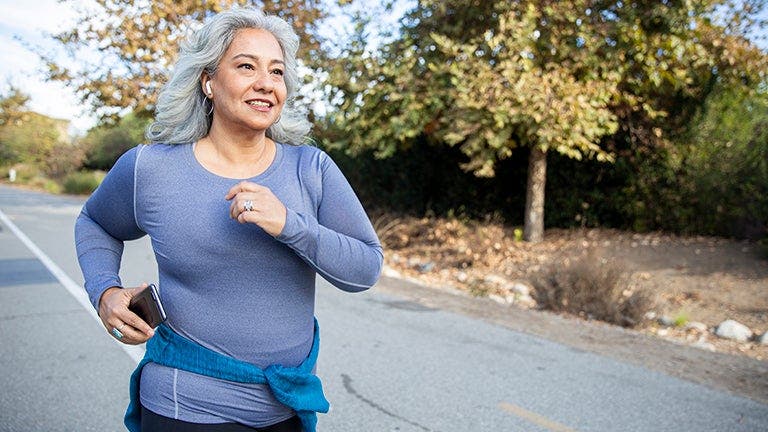6 cardio workouts, explained


What do pole dancing and Peloton have in common? They’re both low-impact, high-intensity cardio workouts. If we lost you at “pole dancing,” don’t sweat it: Soon you’ll be able to I.D. the differences between HIIT and high-impact workouts—or circuit training and kettlebell training—like a pro.
Read on for a deep dive into 6 common types of cardio workouts, so you can find the best options for you.
What is cardiovascular (cardio) exercise?
When it comes to cardio workouts, the options go far beyond walking and running—everything from using an upper-body ergometer to jumping on a trampoline can qualify. “Cardio exercise is any activity that involves moving large muscle groups to increase the heart rate to at least 50 percent of its maximum capacity,” says Noam Tamir, a certified strength and conditioning coach and the owner of TS Fitness in New York City. The heart beats faster and the breathing rate increases to bring more oxygen to working muscles. Over time, this improves a person’s VO2 max—the amount of oxygen the body can utilize—making higher intensity activity easier to perform for a longer period.
Like all forms of physical activity, cardio exercise burns calories, which can help with weight management. But that’s not the only reason to get moving: “Cardio increases the efficiency and endurance of the heart, and improves [overall] muscle endurance,” says Michele Olson, PhD, a fellow at the American College of Sports Medicine and senior clinical professor of sports science at Huntingdon College in Montgomery, Alabama. Cardio exercise can also reduce a person’s risk of developing heart disease by lowering blood pressure and helping improve cholesterol levels, Dr. Olson notes.
How much cardio do you need?
Before we take a closer look at workout types, you may be wondering how often you should do cardio exercise. The Physical Activity Guidelines for Americans recommend adults aim for at least 150 minutes (2 hours and 30 minutes) of moderate-intensity activity, or 75 minutes (1 hour and 15 minutes) of vigorous-intensity activity, a week—spread out over at least three days.
You can gauge how hard you’re exercising with a simple talk test. When you’re working at a moderate intensity, you can easily converse but not sing; at a vigorous intensity, you can only eke out a couple words at a time because you’re breathing more heavily.
6 types of cardio workouts
There’s no “best” cardio workout—any heart-pumping activity will net you the benefits mentioned earlier, Dr. Olson says. That said, some likely are better suited to your particular goals, condition, and lifestyle. Read on to find the best options for you.
1. Low-impact workouts
Any activity that’s easy on your joints is low-impact. But don’t assume this equates to low calorie burn: Activities such as swimming and rowing may not put a lot of pressure on joints, but they torch up to 300 calories in half an hour (depending on a person’s weight and how vigorously they move).
“Calorie burn is dependent on energy output, and you exert a lot of energy by doing movements that use multiple muscle groups,” Tamir says. To increase the intensity of low-impact workouts, such as walking, biking, or using an upper-body ergometer, Tamir adds: “Exercise for a longer time, increase the load or incline, or pick up the pace.”
Anyone can benefit from low-impact workouts. Because they’re relatively easy on joints, they can be especially helpful for people who are just starting to exercise, recovering from an injury, or living with limited mobility or orthopedic conditions, Dr. Olson says.
If you’re looking for a place to start, walking can be a great way to add more activity to your day. You can do it almost anywhere and, best of all, you’ve likely already mastered the how—one foot in front of the other.
2. High-impact workouts
High-impact cardio is exercise that increases heart rate as the body strikes a surface—usually the ground—to generate force. Examples include running, jumping rope, and plyometric exercises. High-impact workouts generally burn more calories than low-impact ones simply because of that strike. As Tamir explains: “It takes a lot of energy to not only produce force, but to absorb force.”
“In addition to providing a big calorie burn, high-impact activities also boost bone strength,” says Liz Van Voorhis, a certified personal trainer and founder and CEO of Fit Collective in New York City. In a yearlong study of more than 5,000 women, researchers found that those who did a workout that included some jumping and running three times a week increased their bone mineral density significantly more than those who didn’t perform high-impact exercise. High-impact workouts aren’t recommended for everyone—if you’re recovering from an injury, new to exercise, or have a chronic health condition, it’s a good idea to check with your doctor before adding them to your rotation.
3. Steady-state cardio
Steady-state cardio is a workout technique you can use with any activity. The goal is simply to work at a consistent, moderate level of intensity for the entire session. When you briskly walk for a half hour or bike a few loops around the park at an even clip, you’re doing it! “Steady-state cardio is ideal for beginners because it’s simple and done at a moderate intensity,” Van Voorhis says. Quick reminder: If you can talk, but not sing, you’re in the moderate effort zone.
4. High-intensity interval training
Also known as HIIT, this type of workout involves alternating between short bursts of vigorous movement (in that can’t-talk zone we mentioned earlier) and recovery periods at an easier level. To reach a high intensity, you can sprint, crank up the resistance, or increase the incline. There’s no set time for HIIT intervals, but since they’re done at an all-out effort, bursts usually last just 30 to 60 seconds, followed by a recovery period that’s typically two or three times longer.
If your schedule is tight—and you’re ready to push yourself hard—this type of training might be your jam. “The combined cardio and endurance benefits you get from HIIT can help accelerate your fitness goals in the most efficient time commitment possible,” Van Voorhis says. A study published in PloS One found that 20-minute HIIT workouts are as effective at improving cardiorespiratory fitness as 40-minute steady-state sessions.
As long as you haven’t been told to avoid vigorous exercise for a medical reason, you can try HIIT. And the best part? It works with nearly any activity. For example, in the pool: Swim a lap as quickly as you can, then do two laps at a moderate pace—that’s HIIT.
5. Circuit training
Remember back in the day when gym classes would have kids do jumping jacks, then hit the ground for push-ups, then sprint? That’s basically circuit training, a type of cardio workout where you perform a series of bodyweight or resistance exercises for a set amount of time or number of reps, then repeat.
Most cardio workouts build muscle endurance—for example, over time running improves how long your legs can continue at a quick pace. Circuit workouts, on other hand, also strengthen muscles. A small, five-week study found that people who did a 30-minute circuit workout three times a week made similar strength gains as those who did 30 minutes of resistance training followed by 15 minutes of cardio—plus, only people in the circuit-training group increased their VO2 max. Bottom line: Circuit training is an effective cardio workout that can net you muscle strengthening benefits, too.
6. Kettlebell training
We know what you’re thinking: Kettlebells are a resistance-training tool. But guess what? The dynamic, swinging motions you perform with those cannonball-shape weights qualify as a cardio workout, too. In fact, a study by the American Council on Exercise found that a twice-weekly, hourlong kettlebell workout significantly improved VO2 max.
”When performing kettlebell movements, you have some control over how intense the cardiovascular training is based on how quickly you move through the exercises,” Van Voorhis says. Just one caveat here: To prevent injuries, it’s important to get the basics down first before picking up your pace.
The upshot: Which cardio workout is best for you?
There’s no shortage of options when it comes to cardio workouts, so there’s almost sure to be one that will help you reach your activity goals. The most important thing is to get your heart rate elevated with some kind of movement on the reg. If you have a health condition or a specific fitness goal, ask your doctor and/or a certified personal trainer for individualized cardio recommendations.
--
Amy Schlinger is a National Academy of Sports Medicine–certified personal trainer. She has more than a decade of experience writing about health, fitness, and nutrition.
